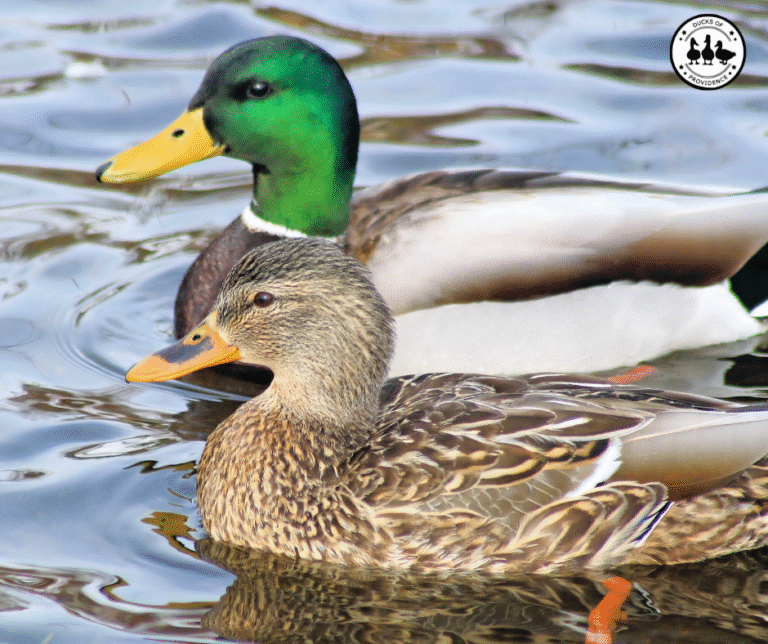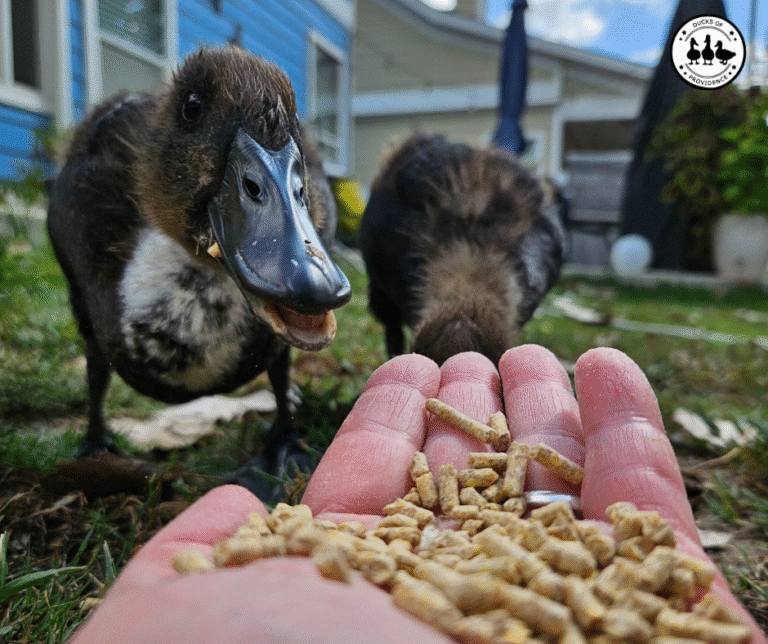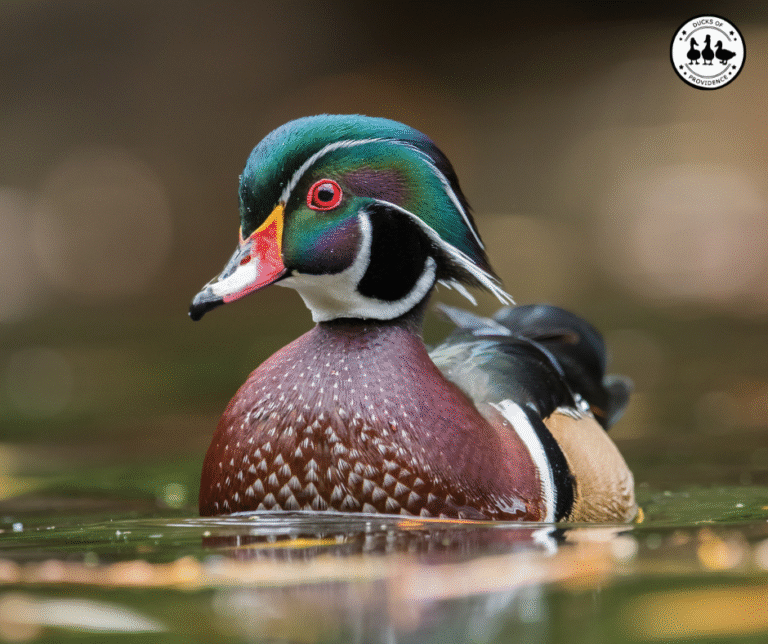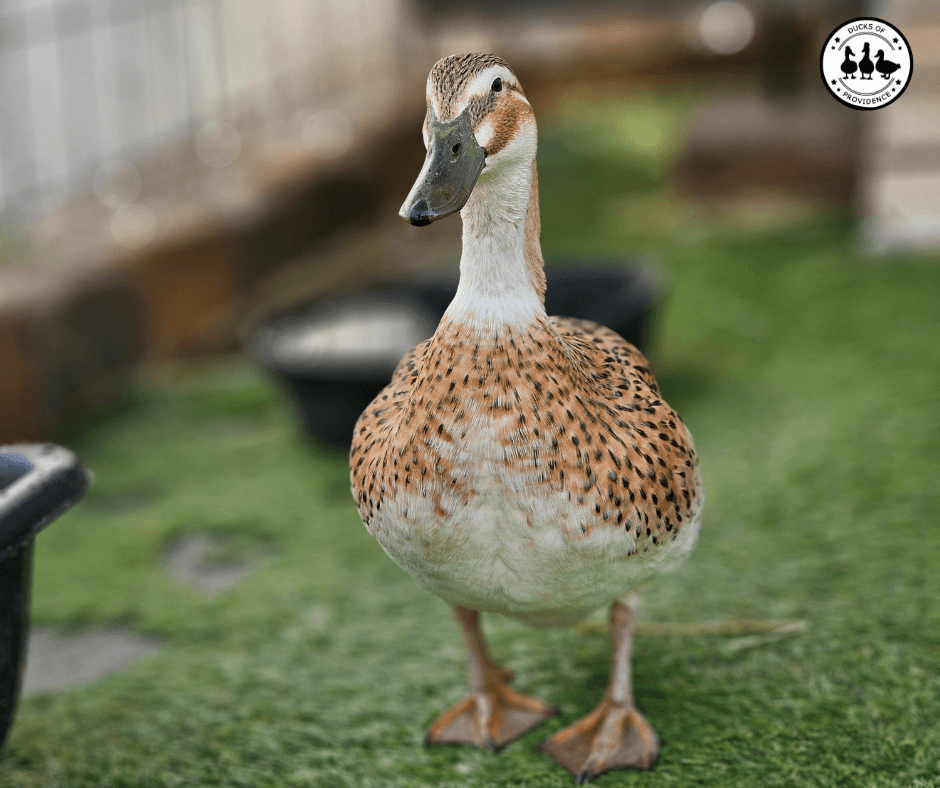
Daily Routine with the Ducks: Summer vs. Winter
Last updated on December 19th, 2024 at 08:10 pm
Many people ask us about our daily routine with our ducks—how we manage their care, balance their safety with their need for enrichment, and adapt to the changing seasons. To answer these questions, we’re sharing a detailed look at what a typical day looks like for us and our flock. From morning feedings to bedtime in their secure hoop coop, our routine is designed to meet their needs while ensuring they stay healthy, happy, and safe. Whether it’s the heat of summer or the chill of winter, our ducks are always our top priority.
Disclaimer: I may earn a commission if you buy products or services through my affiliate links. This will not affect the price you pay. I only recommend products or services that I believe will be beneficial to my readers.
Keeping Ducks Happy in a Suburban Backyard
We live in North Texas, where summers are extremely hot, with temperatures often exceeding 100°F, while winters are generally mild but can occasionally drop below freezing. Spring and fall bring brief periods of more moderate weather, but the climate overall can be challenging.
Our ducks live in a small suburban backyard, and they are kept as pets. They are an important part of our daily lives, and we take their safety seriously. Due to the high number of predators in our area, including raccoons, bobcats, hawks, and snakes, they only roam the yard when supervised. The rest of the time, they stay in a predator-proof hoop coop, which serves as their secure run.
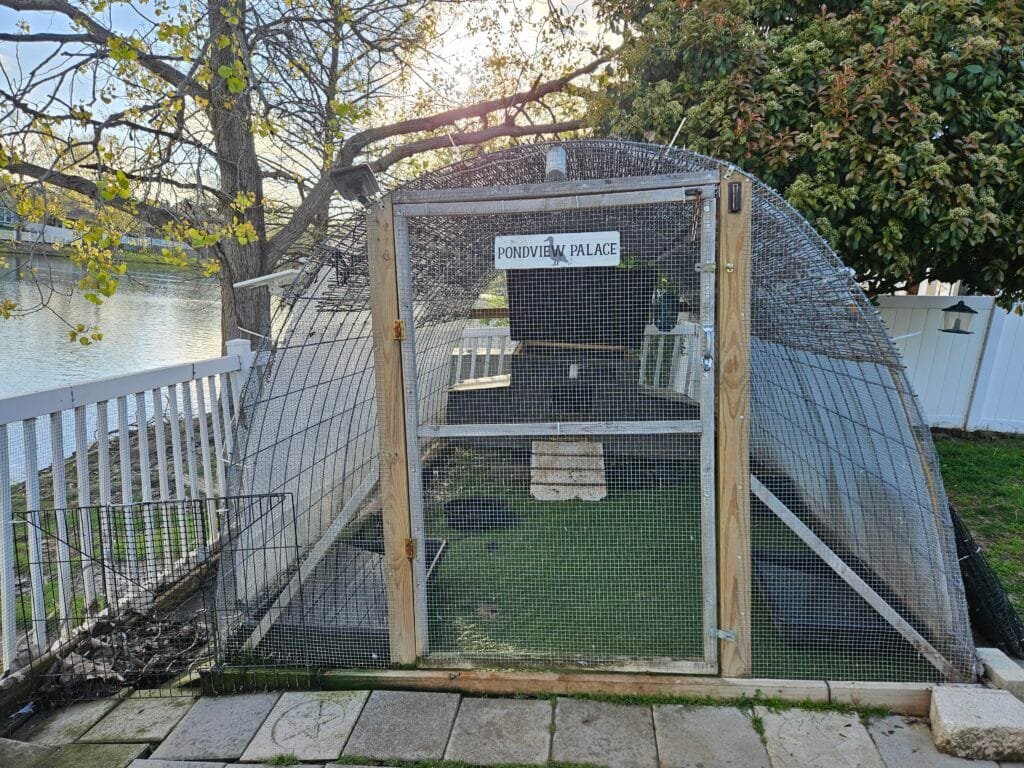
The run has artificial turf as ground cover, which is easy to clean and prevents issues like muddy feet or bumblefoot. Inside the run, they also have a duck house that provides shelter and nesting areas. This setup ensures they have a safe and clean environment while still allowing them plenty of space to move around.
Here’s how our daily routine changes with the seasons.
Summer Duck Routine
Summers in North Texas are hot, so we adjust our routine to keep the ducks comfortable and safe in the heat.
Morning (7:30 a.m.):
The ducks spend their nights in their predator-proof run instead of their house, as it’s far too hot inside. First thing in the morning, I bring them breakfast: a mix of fresh foods like lettuce, tomato, peas, cucumber, and corn. To prevent choking, their food is served in a water bowl, mimicking their natural foraging behavior. In addition to fresh food, they also have access to their commercial duck feed, which is dispensed by an automatic feeder from runchicken that opens at this time.
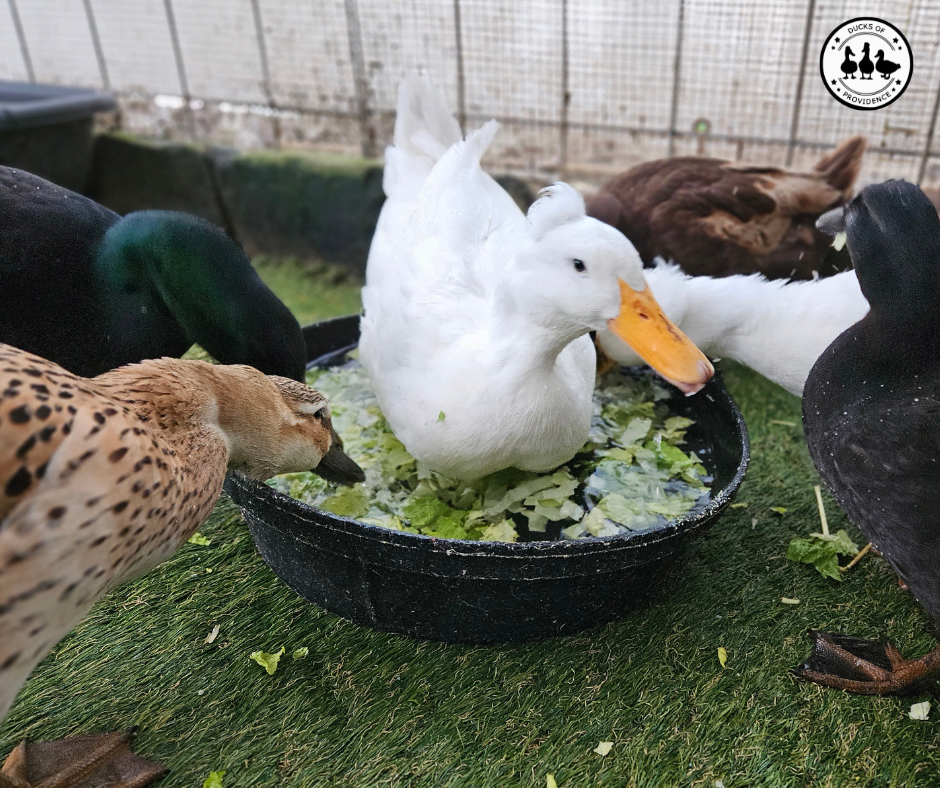
Late Morning (10:00 a.m.):
This is yard time for the ducks and deep-cleaning time for us. While the ducks roam the yard under supervision, we thoroughly clean their run. All water bowls and tubs—of which there are plenty—are emptied, scrubbed, and refilled with fresh water. We also hose down the artificial turf to keep it fresh and hygienic. During this time, we collect the eggs they conveniently lay in their duck house and do a quick spot-clean of the house if needed.
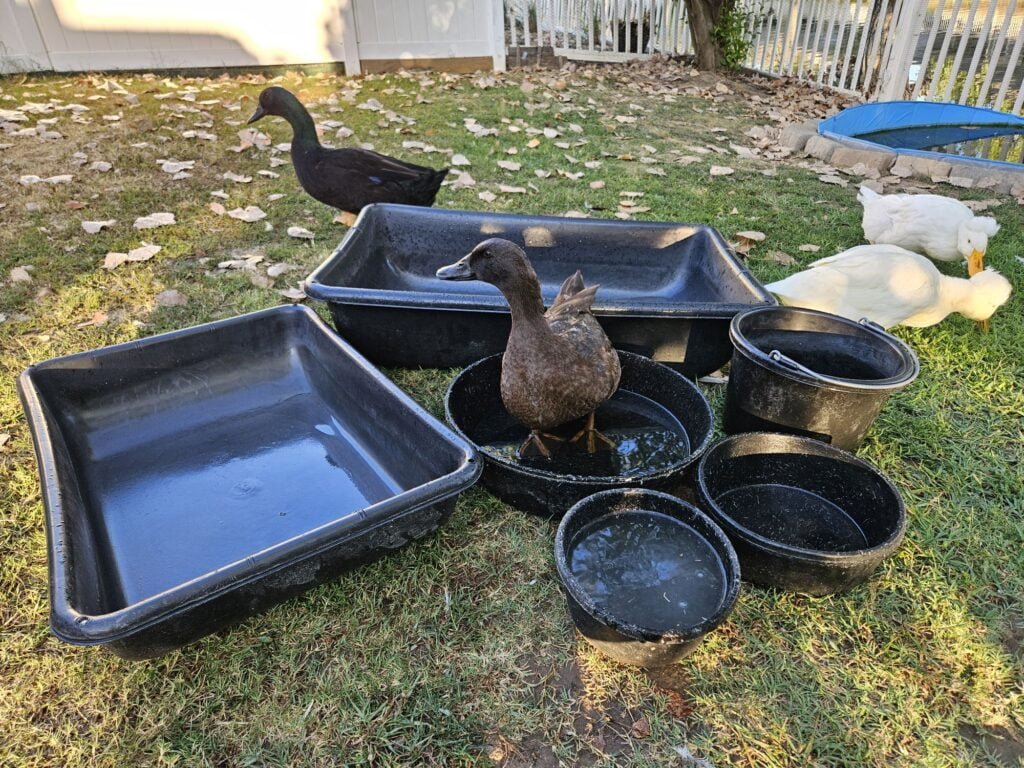
Early Afternoon (1:00 p.m.):
By early afternoon, the heat is usually at its peak. To help the ducks cool off, we provide fresh water, sometimes adding ice cubes for an extra treat, and give them and their surroundings a quick hose down. This keeps them comfortable and hydrated until their next routine activity.

Mid-Afternoon (3:00 p.m.):
By mid-afternoon, we refresh their water again to ensure they stay hydrated during the hottest part of the day. If the heat is especially intense, we turn on their mister to cool the air in their run. We’ll sometimes add extra ice cubes to their water bowls or provide a special bowl with electrolyte water to give them a boost and help them stay cool and energized. These small adjustments keep them comfortable during the sweltering Texas heat.
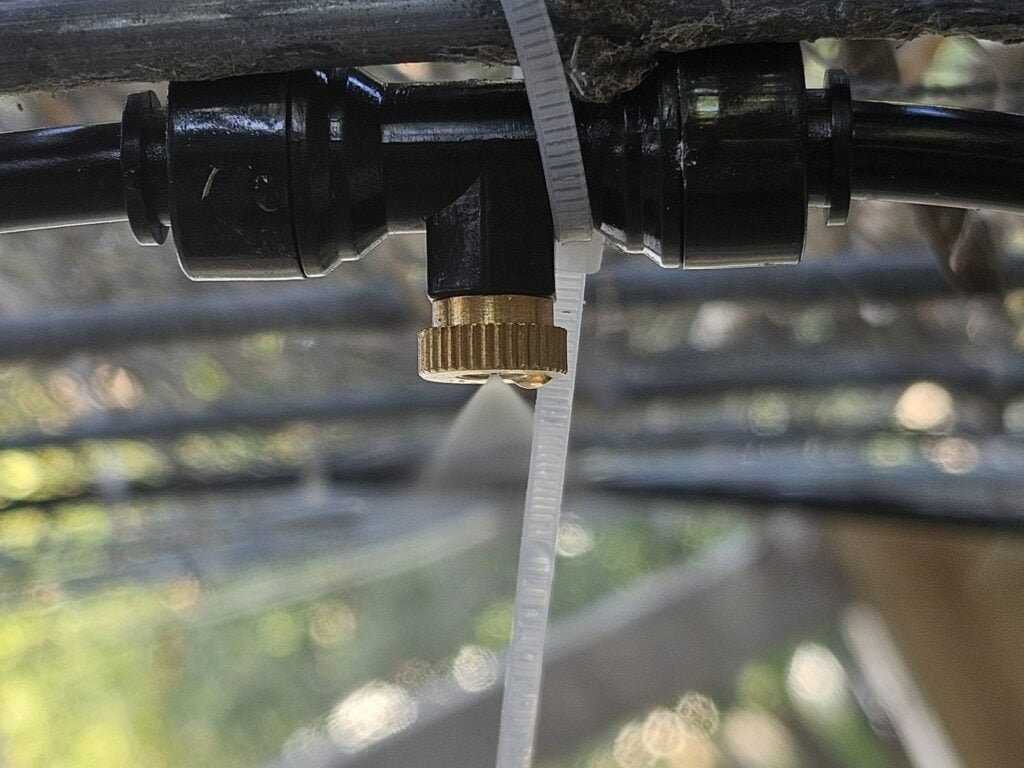
Evening (7:00 p.m.):
As the day cools down, the ducks enjoy a longer yard time. This is when they can roam, forage, and relax under supervision while we take care of evening chores. We change the water in all their bowls, hose down the artificial turf to keep their run clean and fresh, and enjoy spending time with them in the yard. This is one of the most enjoyable parts of the day for both the ducks and us.
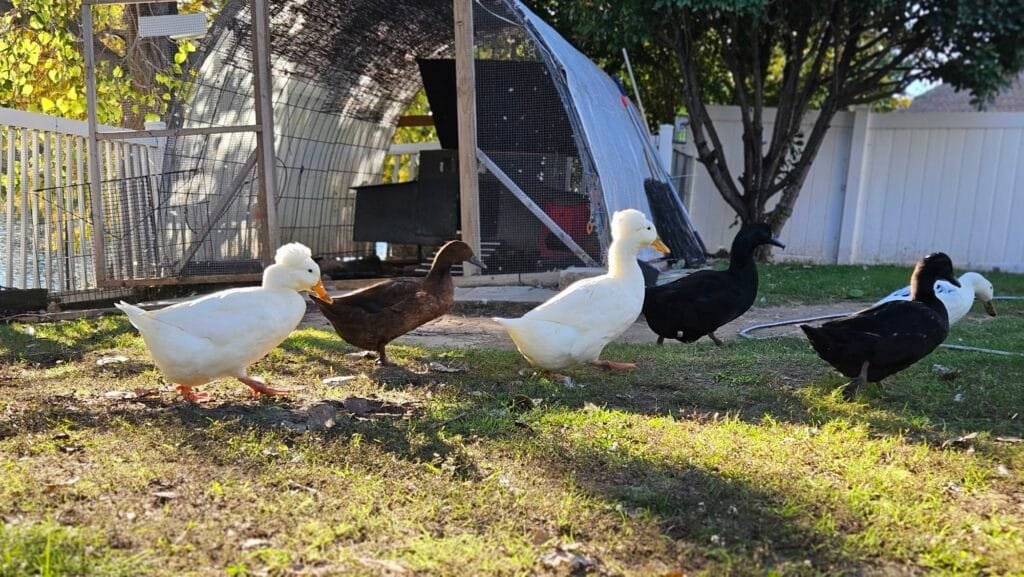
Dinner (8:00 p.m.):
After about an hour in the yard, the ducks head back into their run for dinner. They’re served a fresh mix of vegetables and grains in a water bowl, just like in the morning, to keep their meals balanced and nutritious. Their automatic feeder is still accessible at this time, allowing them to top off with their commercial feed. About 30 minutes after dinner, the feeder closes for the night to prevent any unwanted pests or critters from accessing it.
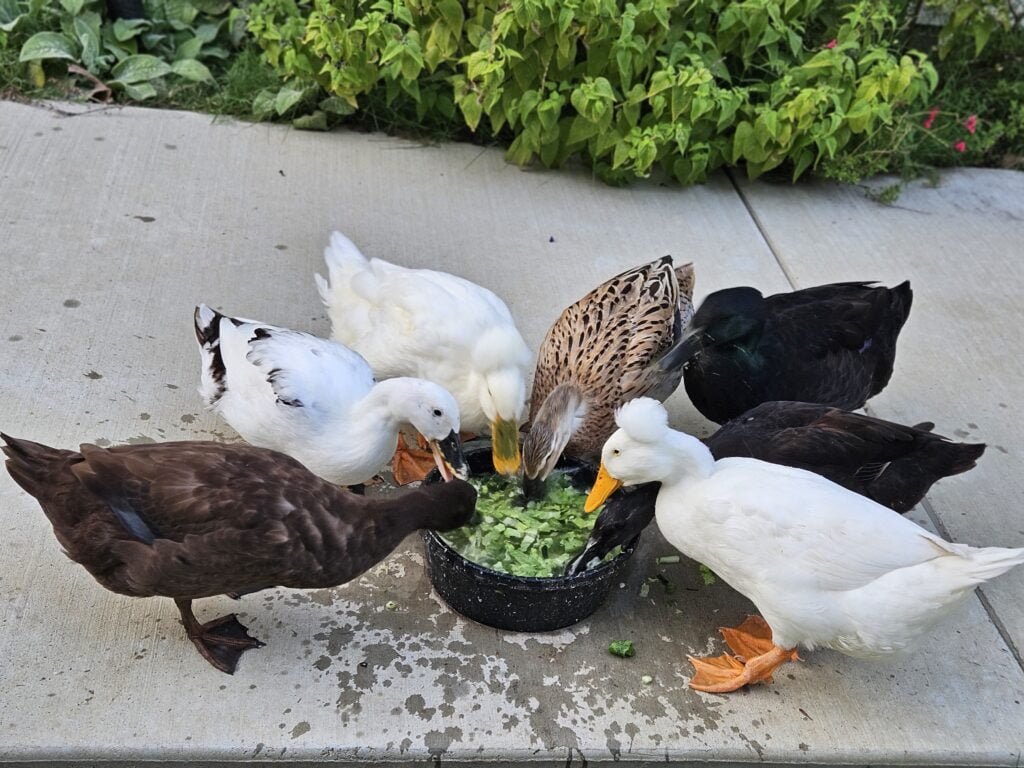
Night (10:30 p.m.):
Bedtime wraps up the day. Before they settle in for the night, the ducks enjoy a nighttime snack of Grubbly Farms treats inside their run. Meanwhile, I give their run one last hose down to keep it fresh and ready for the cooler hours of the night. Because the summer nights are still very warm, the ducks remain in their predator-proof run instead of their duck house to avoid overheating. This setup ensures they stay safe and comfortable through the night.
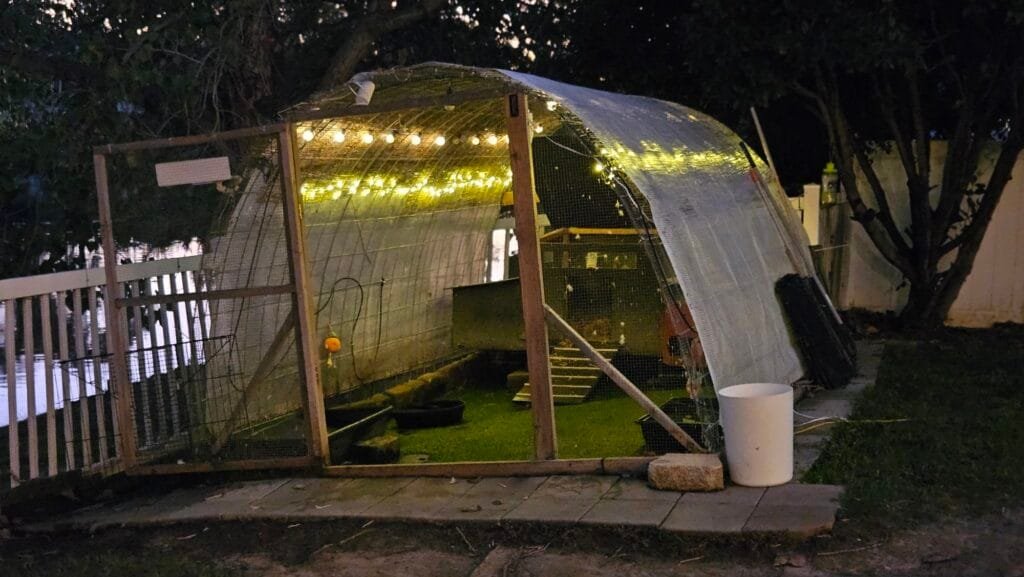
Winter Duck Routine
During the winter months, the routine changes slightly due to the shorter days and colder temperatures, but we continue to prioritize the ducks’ safety, warmth, and well-being.
Morning (7:00 a.m.):
In the winter, the ducks sleep inside their house during the night. This is not only safer from predators, but also warmer and cozier for them. I get up at 7:00 a.m. and let them out of their house into their run, where I serve their breakfast—just like in the summer. They get their usual mix of fresh vegetables and their commercial feed. The colder temperatures mean we take extra care to ensure they’re getting enough nutrition to stay healthy during the colder months.

Midday (12:00 p.m.):
Around midday, we thoroughly clean the run. This includes emptying and scrubbing all the water bowls and buckets, as well as cleaning their house, which tends to get more soiled in the winter since they sleep inside. This is a larger task compared to summer, but it’s essential to keep their environment hygienic and comfortable. During this time, the ducks roam freely in the yard while we work.

Late Afternoon (4:00-5:00 p.m.):
As the days get shorter, we try to give the ducks some extra free yard time earlier in the afternoon, usually between 4:00 and 5:00 p.m., to ensure we’re finished before sunset. The ducks love this time to forage and stretch their wings while we enjoy the cooler weather.
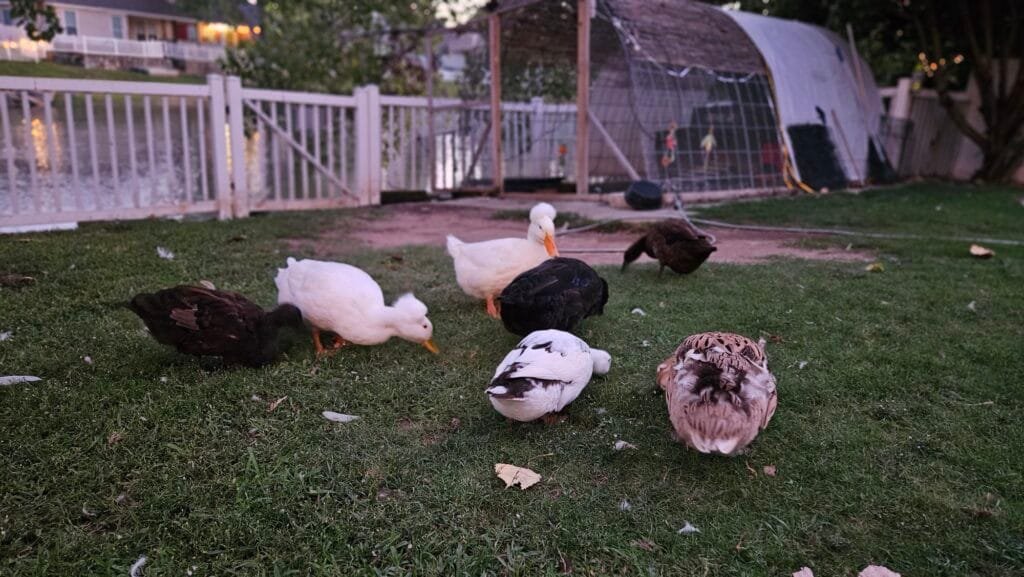
Dinner (6:00 p.m.):
Just like in the summer, the ducks get their dinner, but this time of the year, a bit earlier, at 6:00 p.m. They’re served fresh food in a water bowl, and the automatic feeder provides their commercial feed for another hour. After they finish eating, they stay in their run and take it easy.
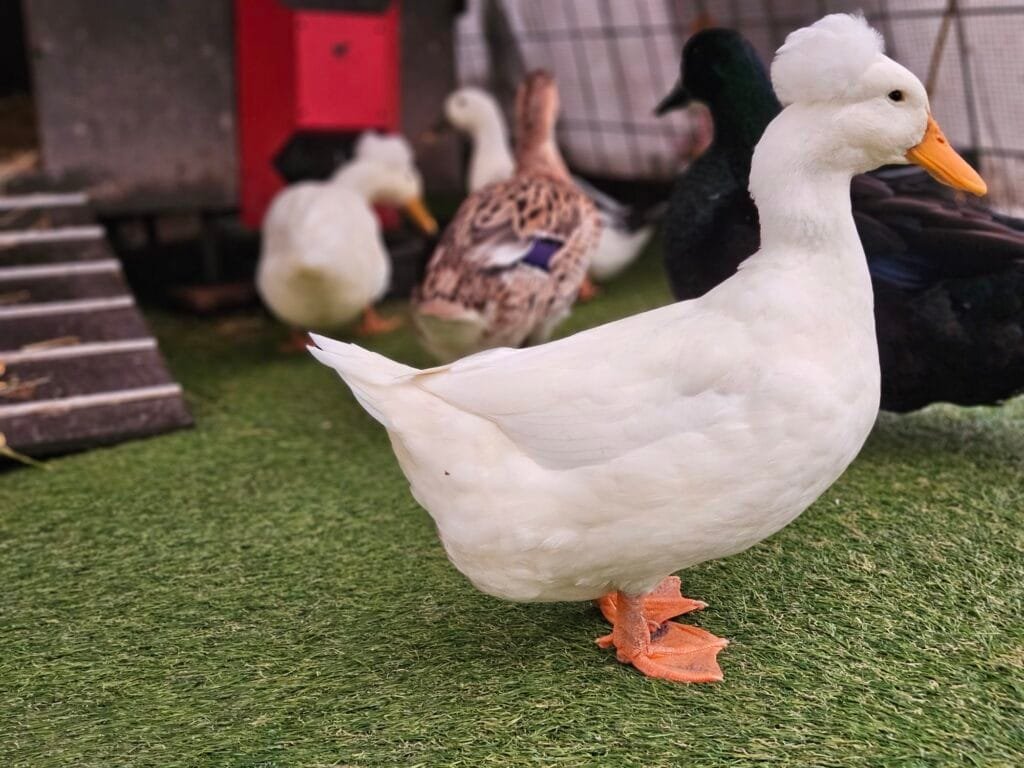
Bedtime (10:00 p.m.):
At 10:00 p.m., we lock the ducks inside their house for the night, where they stay cozy and safe from predators. They get their nighttime snack of Grubbly Farms treats, and I provide them with a bucket of water inside their house. Before heading to bed myself, I do a deep clean of the run to ensure everything is nice and fresh for the morning.
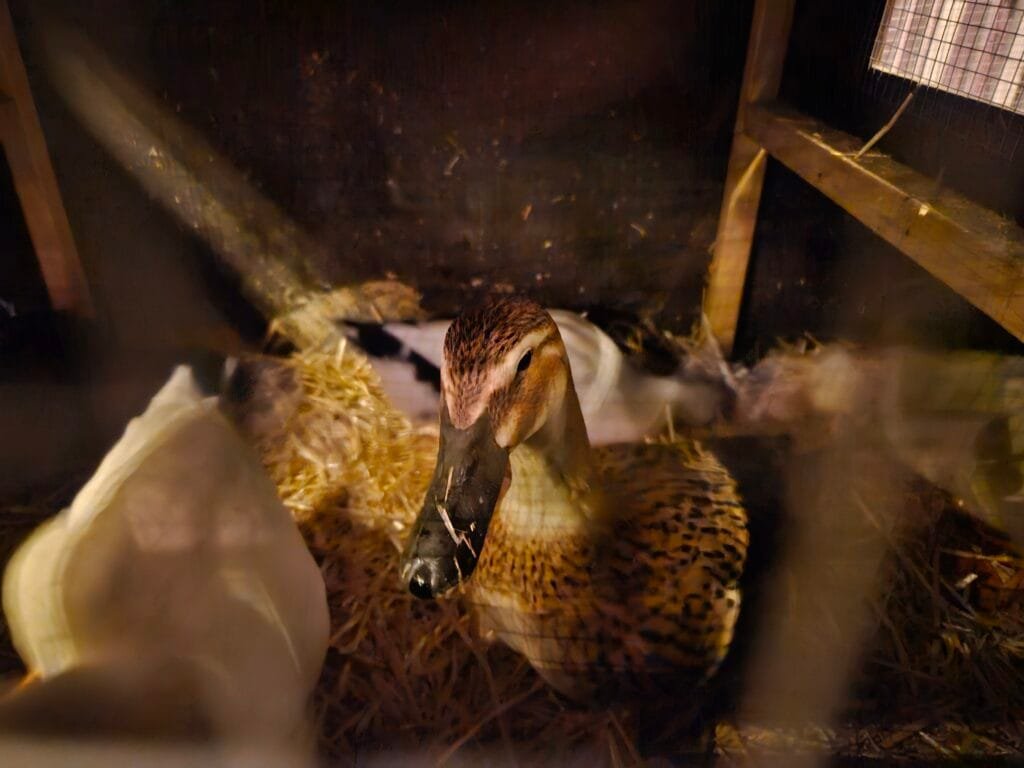
Special Winter Considerations
When the temperatures drop significantly and we start seeing well below-freezing conditions, we take extra steps to ensure the ducks’ safety and comfort. Since their run and house aren’t insulated enough to protect them from extreme cold, we move them inside the garage during particularly harsh weather. The garage provides them with a warmer environment, away from the biting wind and freezing temperatures.
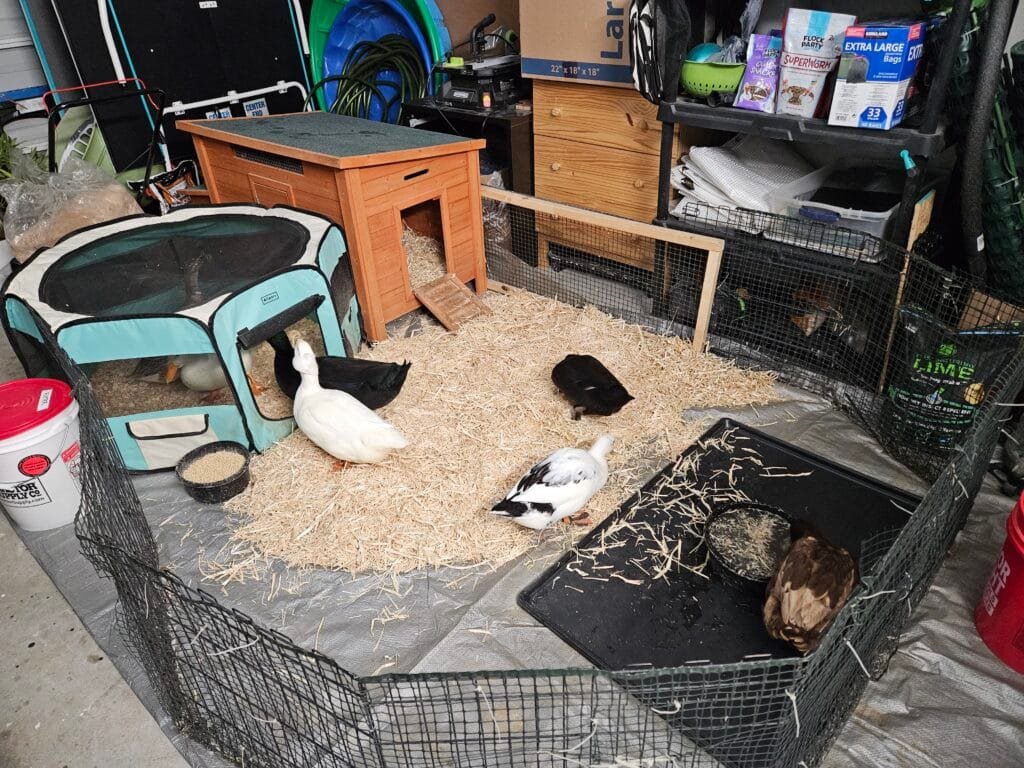
We make sure the garage is well-ventilated to avoid humidity buildup but still insulated enough to keep them comfortable. This temporary move also allows us to keep their water from freezing, and we ensure they have plenty of space to roam and stretch their wings. It’s an extra layer of protection to ensure their well-being through the coldest spells.
Summary: How Our Routine Adapts Throughout the Year
Caring for ducks requires flexibility, as their needs shift with the seasons. Our daily routine evolves based on changes in temperature and daylight hours, ensuring the ducks are comfortable, healthy, and safe year-round. In the summer, we prioritize keeping them cool with fresh water, misters, and extended evening yard time when temperatures are more bearable. Winter brings shorter days and colder nights, so the ducks sleep inside their cozy house, and cleaning tasks increase due to their overnight habits.
During spring and fall, we gradually transition between these routines. As temperatures warm or cool and daylight hours lengthen or shorten, we adjust their bedtime, cleaning schedules, and yard time to match their natural rhythms and needs. While the work required changes with the seasons, our goal remains the same: to provide a safe, enriching environment for our feathered friends.
The Hidden Work Behind Happy Ducks
Caring for ducks in a suburban setting is a rewarding but demanding responsibility. Unlike larger farms where ducks might have more space to roam freely, keeping them safe, healthy, and happy in a smaller backyard setup requires daily effort, from cleaning and feeding to supervising their yard time. The workload increases during extreme weather, like the heat of Texas summers or freezing winter nights, when extra precautions are necessary.
While ducks bring immense joy, companionship, and a unique rhythm to our lives, it’s essential for anyone considering ducks as pets to understand the commitment involved. They’re not low-maintenance animals, but for those willing to put in the work, the bond and satisfaction they provide make every moment worthwhile.
Related Posts:
- Keeping Ducks in Winter – 7 Proven Tips
- Keeping Ducks Cool During the Hottest Months – Effective Tips to Beat the Heat
- How to keep your ducks safe from predators?
- Keeping Ducks 101: A Beginner’s Guide to Duck Care
- Building a Hoop Coop for Ducks with Cattle Panels
- Ducks and Water: Keeping Your Flock Happy and Healthy
- How Artificial Turf Transformed Our Duck Run

